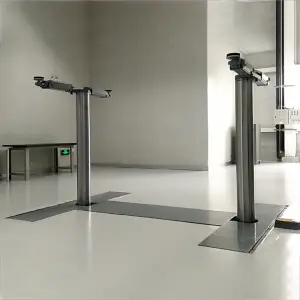****
In recent years, the automotive industry has undergone a monumental transformation with the rise of New Energy Vehicles (NEVs), particularly electric vehicles (EVs). As these vehicles gain popularity for their reduced environmental impact and operational efficiencies, the complexity and significance of their core components, particularly batteries, have also notably increased. Central to the efficient operation and maintenance of these batteries is a crucial innovation: the New Energy Vehicle battery lift. This technology not only streamlines the process of battery replacement and servicing but also significantly enhances safety in the workplace.
Understanding New Energy Vehicle Battery Lifters
A New Energy Vehicle battery lift is a specialized piece of equipment designed to facilitate the handling of heavy battery packs installed in electric and hybrid vehicles. Unlike traditional combustion engine vehicles, NEVs incorporate large, often cumbersome battery systems that can weigh hundreds of kilograms. As such, the necessity for safe and efficient lifting mechanisms becomes paramount in garages, manufacturing plants, and service centers.

Advancements in New Energy Vehicle Battery Lift Technologies: Revolutionizing the Automotive Industry and Enhancing Electric Vehicle Performance
Battery lifts typically feature adjustable heights, robust safety mechanisms, and are composed of durable materials that can withstand the weight and size of various battery configurations. By utilizing hydraulic or electric lifting systems, these devices offer technicians the ability to raise and lower batteries with precision, ensuring that they can be removed or installed without straining the user or risking damage to the battery itself or surrounding components.
Importance of Battery Lifting Technology
1. **Safety First**: One of the foremost benefits of utilizing a New Energy Vehicle battery lift is enhancing safety during battery maintenance. EV batteries contain hazardous chemicals and heavy metals, making them dangerous to handle without appropriate safety measures. A dedicated lifting system minimizes the risk of injury from lifting mishaps and ensures that the handling of batteries follows guidelines set by manufacturers and safety organizations.
2. **Increased Efficiency**: In busy service environments, time is of the essence. A battery lift significantly decreases the time and physical effort required to change batteries. Technicians can quickly and confidently perform replacements or repairs, allowing for improved turnaround times and increased customer satisfaction. This efficiency is essential for businesses seeking to meet the demands of a growing EV market.
3. **Preventing Damage to Components**: The installation and removal of EV batteries can be complex as they are often integrated tightly into the vehicle structure. Utilizing a battery lift reduces the chances of causing unintentional damage to the vehicle’s surrounding components. By deploying a lifting system that provides accurate positioning, technicians can work carefully without risking scratches, dents, or other damage, thus maintaining the vehicle’s integrity.

Advancements in New Energy Vehicle Battery Lift Technologies: Revolutionizing the Automotive Industry and Enhancing Electric Vehicle Performance
Technological Innovations
Recent advancements in battery lift design have included features such as digital controls for precise height adjustments and advanced safety features like automatic locking mechanisms and load sensors. Some state-of-the-art battery lifts are even equipped with sensors that can detect the weight and balance of the battery, automatically adjusting lifting power to ensure optimum safety.
Moreover, as real-time data becomes vital in vehicle maintenance, some battery lifts now integrate IoT capabilities. This allows operators to monitor the performance and usage of the lifts remotely or through connected devices. Alarm systems can notify technicians of any unusual weight distribution, potential for overload, or mechanical faults, thus ensuring proactive maintenance before accidents occur.
Future of New Energy Vehicle Battery Lifts

Advancements in New Energy Vehicle Battery Lift Technologies: Revolutionizing the Automotive Industry and Enhancing Electric Vehicle Performance
The future of New Energy Vehicle battery lift technology appears promising, driven by the accelerating pace of EV adoption and the increasing complexity of battery systems. As manufacturers seek to enhance the design and longevity of EV batteries, the lifting devices are likely to become more specialized and widely adopted.
Furthermore, with the ongoing push for sustainability, manufacturers are also looking at ways to make these lifts eco-friendly, employing materials that are recyclable and processes that reduce energy consumption during operation. Innovations in battery design could also lead to reduced battery sizes in the future, potentially changing the specifications needed for lifting devices.
In conclusion, the New Energy Vehicle battery lift stands as an indispensable asset in the evolving landscape of electric vehicle maintenance. By investing in this technology, service providers can ensure they meet safety standards, enhance operational efficiency, and protect the integrity of NEVs, ultimately contributing to a seamless experience for customers in the electric vehicle era.Inground lift



